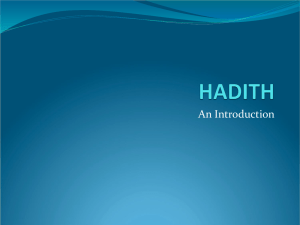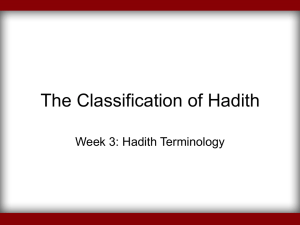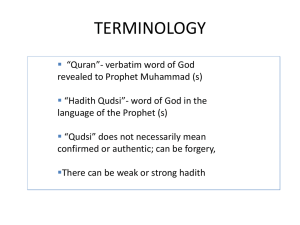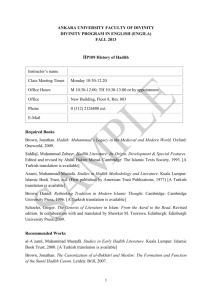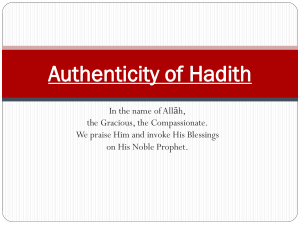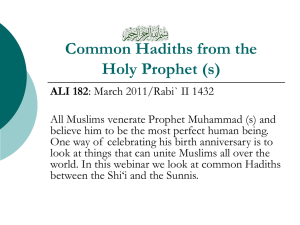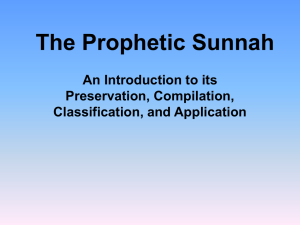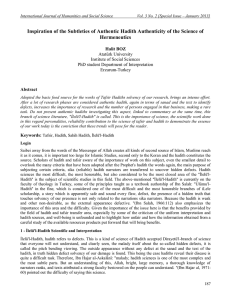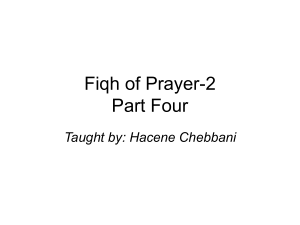Introduction on HOWZA Studies
advertisement
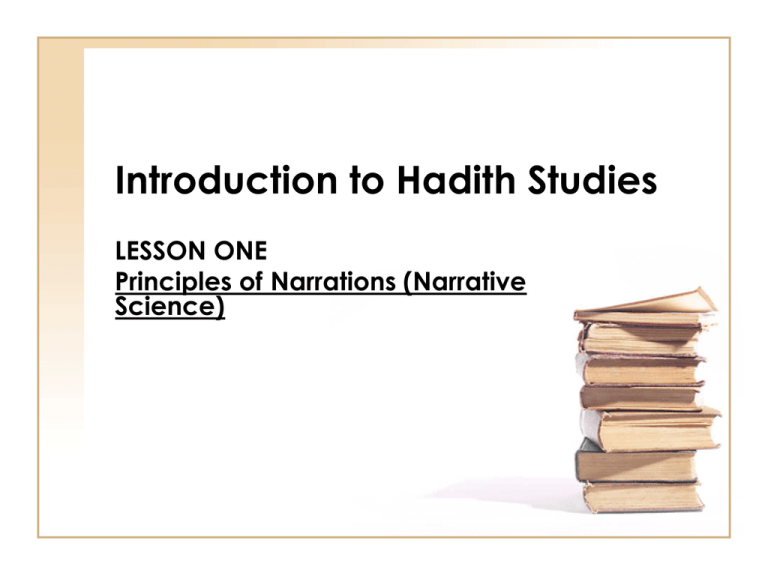
Introduction to Hadith Studies LESSON ONE Principles of Narrations (Narrative Science) Introduction to Hadith Studies With the help of Almighty Allah and the support of our 12th Imam (AJ) we will try to cover the explanation of the book in in 10 lessons. The book is called Usool alHadith, by Dr. Abdul Hadi Al-Fadhli. , and it has been translated by ICAS by the name of INTRODUCTION to HADEETH Law is an important and an inseparable part of Islam. Which is derived from its resources, and since one of the resources of the Islamic Law is the Hadith (narrations), we can appreciate the importance of fully understanding this study. InshAllah, in these ten lessons we will go through some of the components and the main principles of this science, suitable for this basic level. Preface • There is more than one name for this science. This course may be recognized under the following names: ‘Ilm ul-Hadith (The science of narrations), ‘Ilm ul-Diraya (Contextual study of narrations), Usool al-Hadith (Principles of narrations), Qawa’ed al-Hadith (Precepts or Rules of narrations), or Mostalah al-Hadith (Terminology of narrations). • The second martyr (Shahid Al-Thani) was the first to define this science, and since then, the definition has been evolving. For example: 1. 2. 3. 4. The Definitions: The study of the text and the sanad (chain of narrators), by studying the qualifications of those who narrate and transmit the hadith. (Sanad and Matn) The study of status of the HADEETH. This study includes anything that helps substantiate and support the Hadith. (Sanad and everything related to the Hadith) such as the manners of transmitting the hadeeth and any thing about transmitting it (modes and rules of transmission). The study of the sanad only. This is the study whereby the matn (text) has been excluded from this science. This science studies the narration based solely on the narrators, and not the text. Final definition (author) : a science in which the specifics of the chain of the transmission or the narrators are analyzed along with the standards of its admissibility. In other words the degree of validity of the chain of narrators or transmission. (Study of the level and type of Sanad). • The science which studies of the narrators, (‘Ilm ul-Rajaal), explores the principles of identifying the proper narrators. In this science (‘IIm ul-Haeeth), we define (title) the narration itself based on the level of the narrator, and not the text. Subject of this science • The study of the narrations (HADEETH) examines the types, levels and the value of the sanad (support of the hadeeth),and the qualifications of the narrators and transmitters. • In others words describes the HADEETH with a title. Benefits of this science • Since Hadiths are the second Islamic resource often referred to, we can imagine the importance of a science that determines the validity and authenticity of the Hadith. There are many narrations that have been fabricated or altered. That is why it has become very important for us to carefully scrutinize and research the authentic Hadiths, especially when matters of Islamic Law and deduction (Ijtehad) are concerned. The relation of this science with other sciences 1. ‘Ilm ul-Rajaal (the study of narrators): This science studies the specifics of each narrator, such as their religious status in rank, and their trustworthiness. Then, we implement general rules and principles provided by Hadith science. In this type of study, we define the value of the narration and categorize the Hadiths. The relation of this science with other sciences 2. Usool al-Fiqh (Islamic Jurisprudence): By using the science of studying the value and type of Hadiths, Usool alFiqh provides us with the validity of the Hadith, indicating whether it is Hujjat (conclusive proof) or not. • By scrutinizing the Hadith through both the above mentioned sciences, we can come to a conclusion about the authenticity of a Hadith. • Example: • Is the narrator of the Hadith trustworthy person? ‘Ilm ul-Rajaal • Is the Sanad considered to be saheeh? Usool al-Hadith • Is there a conclusive proof (Hujjat)? Usool al-Fiqh • Is the Hadith suitable to derive a law from? Jurisprudence (Fiqh) • The conclusion could be Islamic Law (Fatwa)/or an Islamic Fact (i.e. theological, historical interpretation of Hadith) • Note: The rules of authentication are severely strict in deducing the law, but could be less strict in deducing historical fact or ethical value. History of Hadith Science • The first historical script regarding this science is recorded by Imam Ali (as). When asked how to distinguish a true Hadith from a false one, he replied that the Prophet (pbuh) had said, “O people! There are many who have falsely narrated Hadiths by me that are not true, and whosoever does that intentionally, chooses his own place in the hellfire”. Imam Ali (as) further responded classifying the narrators of Hadiths into four categories: 1. A hypocrite: one who portrays himself as a believer, but does not hesitate to produce false Hadiths. 2. A person who, unintentionally does not narrate the Hadith verbatim, and then denies the possibility that he could have made a mistake in the narration. 3. A person who, unintentionally narrates a Hadith that has been abrogated or modified but is not aware of a change to the Hadith. 4. A person who despises lying, fears Allah, and narrates the Hadith exactly as it was spoken by the Prophet verbatim. • These are some brief principles on how to determine if a narration of a Hadith is authentic. More of these principles are as follows: • Do not narrate a Hadith said by us (Ahlul Bayt), unless there is clear verification of what was said, and whether or not it was truly said by us (Ahlul Bayt). • Another criterion for verification of a Hadith was instructed to Zorarah by Imam As-Sadiq (as). If two Hadiths are in conflict, then we must take either: (a) Take the popular Hadith and abandon the less popular one (b) If both are equally prevalent then take the Hadith which is narrated by the more trustworthy narrator. • Some of the principles of Hadiths were mentioned in the books of narrators (Rajaal), some were mentioned in the 4 compiled books of Hadiths, and some were mentioned in the books of Usool al-Fiqh, such as books of Sheikh Mufid, and Shareef Al-Murtada. The principles of Hadiths were scattered in different books. It was not an individual science until the first Imami author wrote an individual book in this science. He was a student of Allama Al-Hilli during the eighth century. Shahid Al-Thani (10th century) was the first person to organize it and stabilize it. His famous book is known as Diraya, both parts (Bidaya Sre’aya). After Shahid Al-Thani, there were other scholars who modified and edited his works. General Definitions • Hadith, Khabar, and Athar (Sayings, information, and mark prints): There has been a historical disagreement in the school of companions about the three definitions. However, in the school of Ahlul-Bayt (as), these three words are synonymous for the holy Sunnat. If the three words have different meanings, then there must be a clue of context for their understandings. This Sunnat could be the saying, an action or acknowledgement of an action by an Infallible (as). General Definitions • Rewaya (narration): Rewaya literally means transmission, and to narrate. idiomatically or in the hadeeth terminology it means a narration or a saying with the support of narrators. It may also have different grammatical meanings. Recent scholars (ALKHOEI) have specified Rewayat to a narration which has not yet been verified as being authentic (Saheeh), good (Hassan), or dependable (Mowathaq). • Rawee: This means the one who narrates poetry in pre-Islamic times. But, after Islam, it means the one who narrates the sayings of the Infallibles (as). It is the one who transmits and narrates the sayings of the Infallible (as). • Raweeya: This is the one who narrates many/plenty.
